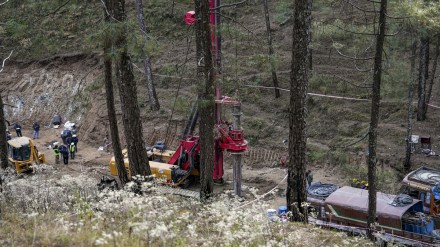In a race against time, rescue teams have picked up the pace in their efforts to save 41 workers trapped for over two weeks in the Silkyara-Barkot tunnel in Uttarakhand’s Uttarkashi after it collapsed on November 12. The vertical drilling has progressed so far from the top of the hill, with 31 out of 86 meters completed, necessary to reach the trapped workers.
Currently, the drilling work is underway to install a pipeline aimed at aiding the rescue. The diameter of the pipeline is 800/900 mm or 1.2 meters.
The decision for vertical drilling was made after the breakdown of the auger machine, previously being used for horizontal drilling in the tunnel, ANI reported.
Also Read:Uttarkashi tunnel collapse: Plasma cutter flown in to remove auger blades from rubble
Official sources have confirmed that the American auger machine, trapped within the tunnel debris, has been completely severed using a plasma cutter. However, during the process, a 2-meter section at the end of the pipeline (between 48 to 50 meters) has become twisted. Officials have highlighted that removing this section presents a significant challenge, ANI reported.
At present, it is difficult to provide an exact timeline for when the manual drilling will begin. However, according to the National Highways and Infrastructure Development Corporation Limited (NHIDCL), the drilling work is predicted to be completed by November 30.
Also Read:Uttarkashi tunnel collapse: Rescue operations come to a halt following hurdle, drilling stopped
NHIDCL Managing Director Mahmood Ahmad addressed a press conference in Uttarkashi, highlighting the need to drill approximately 86 meters within four days, aiming for completion by November 30. He expressed hope for an obstacle-free process to meet the deadline while prioritising the safe rescue of the 41 workers.
Ahmad said, “We too thought about this issue. A committee has been formed over this, and the findings will be out. As of today, our first goal is to safely bring out our 41 workers.”
A committee is investigating the creation of an escape passage, with findings forthcoming. Meanwhile, a unit of Madras Sappers, an engineer group from the Indian Army, joined the site on Sunday to conduct manual drilling.
The engineer regiment, comprising 30 personnel, is already present to expedite rescue efforts. Manual drilling involves rat boring by the Indian Army and civilians using tools like hands, hammers, and chisels to clear debris inside the tunnel. An official mentioned that this process will involve pushing the pipe forward from a constructed platform within the tunnel.
